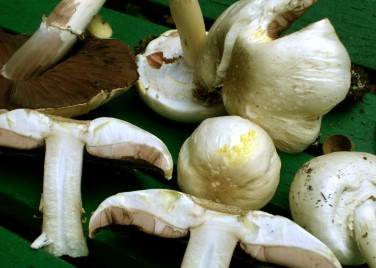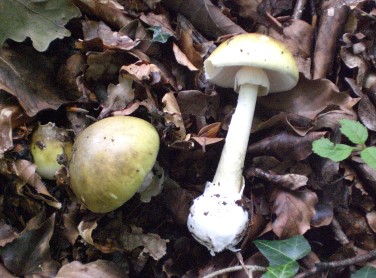Don't Eat This - Things The Wild Food Forager Should Avoid
By Mike on Thursday, September 9, 2010, 22:44 - Permalink
 A load of mushrooms sprang up right in my garden - at first, I thought I had a good crop of Wood Mushrooms. My excitement turned to disappointment, however, when the fungi proved to be specimens of The Yellow Stainer.
A load of mushrooms sprang up right in my garden - at first, I thought I had a good crop of Wood Mushrooms. My excitement turned to disappointment, however, when the fungi proved to be specimens of The Yellow Stainer.
This article also explores a selection of other things that the wild food forager should be aware - and wary - of.
Identification Of Wild Fungi
The description here is not intended to be sufficient for conclusive identification of these wild fungi - the reader should understand that the possible outcomes of misadventure with wild-gathered fungi include serious illness and death.IT IS YOUR OWN RESPONSIBILITY to take adequate steps in identifying any fungi you gather for the table - doubly so if you are intending to share them with someone else.
Informal descriptions, such as the one on this page, are not adequate for full identification - it's just good sense to fully and independently verify everything you read here.
Rules of thumb or folk wisdom identification methods are frequently unreliable.
Consult a comprehensive identification guide (I recommend Roger's Mushrooms (site no longer available - see here) and Wild Mushrooms Online) or best of all, talk to a living human expert mycologist.
Yellow Stainer Mushroom

What Is The Yellow Stainer?
Agaricus xanthodermus - this close relative of field mushrooms and horse mushrooms is similar in initial appearance to both and so is possibly one of the most likely candidates for accidental poisoning, if you're not careful with the identification.
 It has the characteristic Agaricus look - white, slightly scaly cap and pinkish gills that darken to chocolate.
It has the characteristic Agaricus look - white, slightly scaly cap and pinkish gills that darken to chocolate.
The smell is quite a useful diagnostic - unlike the mushroomy or aniseed scents of some other species in this genus, the Yellow Stainer has a rather unpleasant soapy, inky smell.
 Here's a hint of the other key diagnostic - from which the fungus draws its common name - yellow staining.
Here's a hint of the other key diagnostic - from which the fungus draws its common name - yellow staining.
When picked, the base of the stem is often already marked with deep chrome yellow patches, but all white parts of the mushroom turn yellow quite quickly when scraped or crushed.
 Breaking the cap of the mushroom or cutting it with a sharp knife doesn't always reveal the yellow staining staight away - although it will usually appear after a few minutes exposure to air.
Breaking the cap of the mushroom or cutting it with a sharp knife doesn't always reveal the yellow staining staight away - although it will usually appear after a few minutes exposure to air.
A cross-sectional cut through the stem, however, will turn deep yellow straight away.
 Here's another look at a broken piece of cap - it wasn't initially showing any yellow staining, but the colour appeared immediately upon bruising the flesh with the point of a knife.
Here's another look at a broken piece of cap - it wasn't initially showing any yellow staining, but the colour appeared immediately upon bruising the flesh with the point of a knife.
So... that's the description - and you should not eat this - for details of the reasons why not, read on...
What Happens If You Eat This
This is listed as a poisonous fungus in all the books - it's not an especially dangerous one - probably not deadly, but the symptoms of poisoning (which don't always affect everyone) sound deeply unpleasant - any or all of: sweating, hot flushes, abdominal cramps, nausea and vomiting.
However, the inky, soapy flavour is likely to put most people off eating it, but one mushroom in a mixed basket could be masked by the flavour of the others, but could still be enough to cause poisoning - that's why all of the mushroom pages on Atomic Shrimp carry this warning:
Sea Pea
August 2012 - Whilst on a short camping holday in Dorset, we visited Chesil Beach - one of relatively few locations in the UK where the Sea Pea may be found.
Described as edible by many wild food references, this is actually not one to make a habit of eating - please see the edibility warning at the foot of this page.
What Is The Sea Pea?
Lathyrus Japonicus - also known as Beach Pea and Circumpolar Pea, this low-growing, tough, conspicuously-leguminous plant has quite a wide range worldwide, but is only found in one or two locations in the UK.
This plant is a perennial, but unlike many of its close relatives (including the garden Sweet Pea), and despite bearing tendrils on the end of each leaf stalk, it isn't a climber - instead, forming clumps or dense, ground-hugging mats, typically on beaches formed of deep shingle.
The attractive flowers which range in colour from pale magenta to deep blue-purple (and occasionally, pure white), are followed by bunches of small pods, each bearing about five or six seeds.
In all but size (they're about 3-4mm across) the seeds resemble garden peas. I have eaten them exactly once (before I learned of their toxicity - see below), and I can report that they are also similar in taste - although a little more mealy and chewy in texture.
Also unlike many of its relatives, the seed pods don't spring open, ejecting the seeds when ripe, but instead, wither and remain tightly shut. I imagine this is an adaptation to the marine environment - and perhaps the dried pods provide additional buoyancy and protection for the seeds, as they are distributed by ocean waves and currents.
Some wild food references state that the dried seeds may be cooked and eaten similarly to lentils, however, I expect the same risks exist here (see below).
Edibility Warning
Although many texts describe this plant as edible, and say nothing more, the seeds contain Oxalyldiaminopropionic acid, which is a neurotoxin.
Probably fairly harmless in small quantities - if consumed regularly, this causes a disease called Lathyrism - the symptoms of which include loss of strength - eventually paralysis - of the legs and (I'm not kidding) atrophy of the buttocks.
So I don't recommend this plant for the wild food table.
Chesil Beach
I've lived near the coast all of my life, and it's an environment I'll never get bored of - and Chesil Beach is quite unique and special.
Chesil Beach is a remarkable 18-mile-long bank of shingle linking Abbotsbury to the Isle of Portland - for most of its length, the beach forms a barrier, bordered by water on both sides (the Fleet lagoon to the northeast and the English Channel to the southwest.
On the seaward side, the beach slopes sharply into deep water, making it a popular location for fishing, however, these same conditions make it dangerous - this beach, with its violent surf, swift tidal currents, exposed and remote location and loose, shifting surface, can and does claim lives.
Cherry Laurel
Cherry Laurel - Prunus laurocerasus - is a large shrub or tree with oval, glossy leaves about 10 to 15 cm long. It is widely planted in gardens and landscaping as hedging.
It bears spikes of pungent whitish green flowers in spring, followed in late summer by ovoid, dark red or black cherry-like fruits.
All parts of this plant are poisonous - containing prussic acid (hydrogen cyanide)
Of particular concern are the fruits, because they very closely resemble black cherries (this resemblance is no coincidence - the plants are closely related)
Fortunately, they are reportedly very bitter to taste (I feel disinclined to verify this myself), so the risk of ingesting a fatal dose is somewhat diminished, however, it's worth making sure that children are aware of the poisonous nature of this plant
Common Ink Cap
This one probably won't kill you (at least, there are no recorded cases of fatality)- in fact, with some care, it's quite edible.
The Common Inkcap - Coprinopsis atramentaria is a common fungus of grassy places and road edges - it has a bell-shaped cap which is greyish at first, quickly turning to dark brown or black as the fungus ages and eventually dissolving into inky liquid (hence the common name)
This mushroom is edible - indeed, tasty - but there's a catch. If it is eaten while alcohol is in the body, it causes violent sickness and other quite alarming and unpleasant symptoms such as palpitations and tingling sensations in the limbs
The effect can persist so that sickness accompanies even moderate alcohol consumption up to several days after eating the mushrooms
So... not worth the risk, in my opinion
Death Cap
 Amanita phalloides - the Death Cap. The common name is a bit of a giveaway - this fungus is horribly deadly.
Amanita phalloides - the Death Cap. The common name is a bit of a giveaway - this fungus is horribly deadly.
If you're interested in foraging for wild mushrooms, get some good reference materials and acquaint yourself with this fungus - it's a good way to get a feel for the importance of 100% positive ID when gathering wild fungi.
For the Northern European fungus forager, it's not a huge risk, because there's not much you'd want to eat that looks like it.
Cases of accidental poisoning from A.phalloides sometimes happen when people familiar with the fungi of Asia visit Europe - because the Death Cap is quite easily mistaken for the edible and popular Asian Paddy Straw Mushroom.
However, the resemblance is superifical - that is - it's still quite possible to completely and positively identify fungi - mistakes happen not because the fungi are inscrutable, but because people lack the knowledge, patience or inclination to perform the identification.
The Importance Of Positive ID
It's important not to get too casual about identification of wild food resources - not only when you're starting out, but when you think you're experienced too - anyone can make a mistake
Scarcely a year goes by without reports in the news media of someone being poisoned by wild food (usually fungi)
Most often, this happens when people travel outside of their native area and mistake something local and poisonous for something edible back home.
Safety
So... safety consists mainly of not ever relying upon any assumptions - using a reliable field guide to comprehensively identify candidate wild foods - it is possible to become familiar enough to rely on memory alone, but that familiarity should not bring about carelessness.
